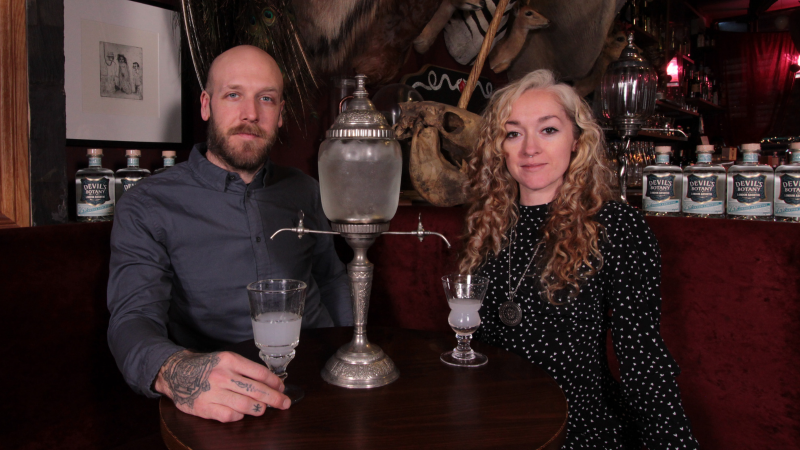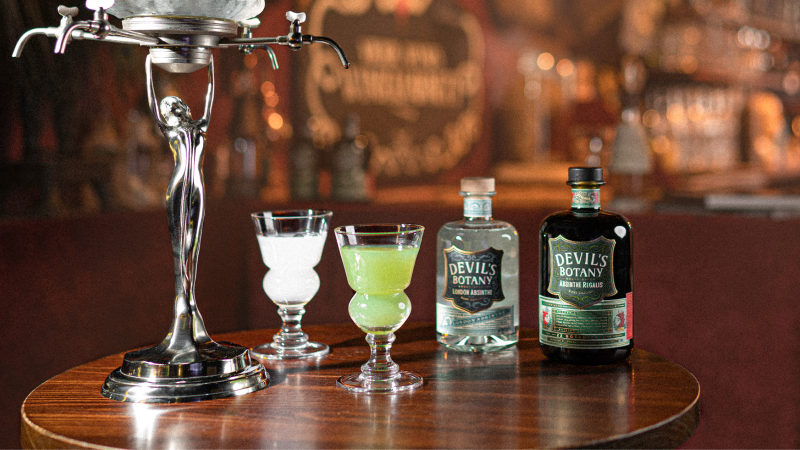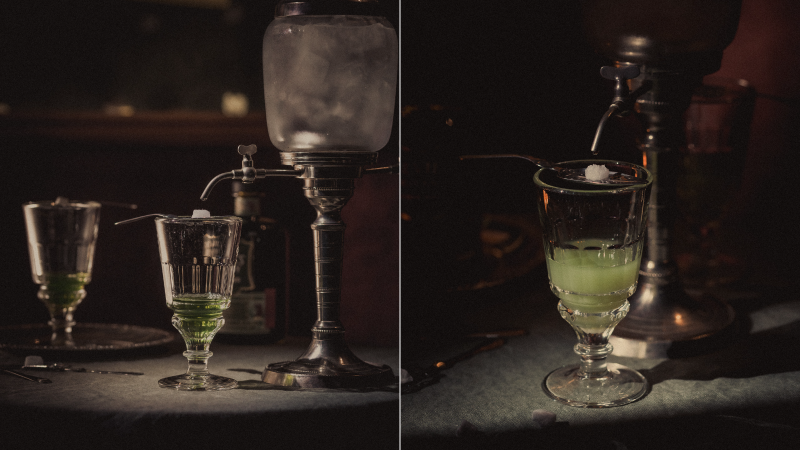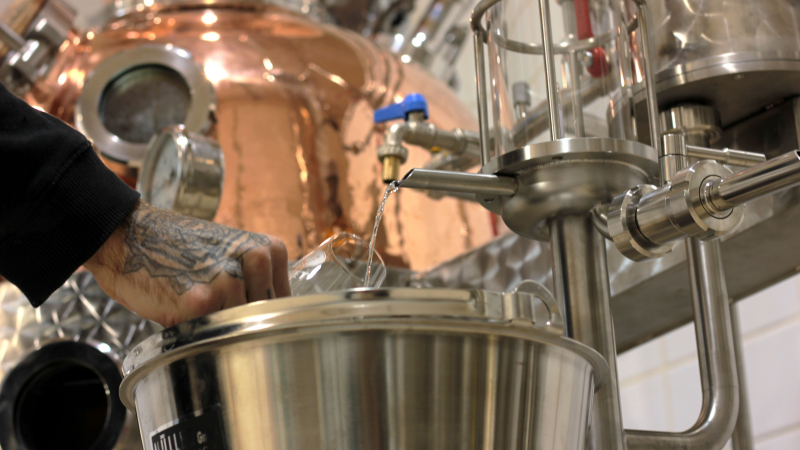Type City, bar name or keyword...
Meet The Maker: Allison Crawbuck, Devil's Botany
You've noticed absinthe on back bars. You may have tried it in a classic Sazerac or a Death in the Afternoon, where the botanical spirit adds a kiss of aniseed flavour. And you've probably seen Kylie strutting her stuff as a little green fairy in Moulin Rouge. But how much do ya really know about absinthe? You'd be forgiven if the answer is not a whole damn lot.
Allison Crawbuck is trying to change that. With her partner Rhys Everett, she's the co-founder of Devil's Botany, the UK's very first dedicated absinthe distillery, as well as The Absinthe Parlour at The Last Tuesday Society in Hackney. We caught up with her to learn how she's putting absinthe back on the map for UK drinkers.
Hey Ali! Let's go back to the beginning. How did ya get your start in the drinks industry?
My accent gives it away - I'm American, and I worked in the art world in New York before I left. Then I moved to London, and I started working in a pub. That was my crash course in British culture! I had to learn about all things banter and pints and football and everything about living in London, through the pub. And that's where I met my partner, Rhys.
An opportunity became available at The Last Tuesday Society and Viktor Wynd Museum, which has been [in Hackney] since 2009. They had a cafe-bar when they first opened for about a year, and it didn't work out. We spoke to Viktor Wynd about taking over and opening an absinthe parlour here. We put in business loan applications and got a Virgin StartUp loan, which absolutely saved us! We did everything on a whim, really.
We opened The Absinthe Parlour in 2016 and immediately started looking for absinthes to have on our menu. At the time, there weren't very many examples of traditional absinthe available. We got our hands on an absinthe that will remain unnamed. It was the colour of mouthwash. We were like, this is pretty electric green, this is strange. And then we added water to it, and the beautiful transformation from clear to cloudy [called the louche] didn't happen, and when we tasted it, everything felt wrong. So our love of absinthe really started with a pretty bad glass of absinthe, funnily enough, and we worked backwards from there.

Partners in biz and life Rhys Everett and Ali Crawbuck at The Absinthe Parlour
Absinthe has a pretty wild history (it was banned in the US and lots of Europe in the 20th century!). How did you go about diving into the spirit's past?
We started doing lots of research into what a traditional absinthe would have been. We travelled to France and Switzerland - the two regions with the majority of the distilleries leading up to the ban were Pontarlier in France and the Val-de-Travers in Switzerland, and we went to these regions and met with the distillers that kept the spirit of absinthe alive throughout the prohibition. They were distilling, perhaps illegally, for generations in between! And then once the ban got lifted, they were able to recreate the recipes that they were making in the early 1900s.
So we set up as a small importer and brought over their absinthes. We were able to share their stories with our customers here at The Absinthe Parlour, which was amazing. We collected the largest list of absinthe available in the UK. Now, because of Brexit, we're not able to import as a small business anymore, so the bottles that we have on the back bar are even more precious. When they're gone, they're gone. A lot of the producers we work with have been doing making absinthe for a long time, and if they retire, that's the end of that distillery, that recipe and that family lineage with absinthe.
And what was your journey to starting your own absinthe brand?
We had been exploring the origins of absinthe for a long time, and in doing so, we found newspaper articles from year 1900 saying that there was going to be an absinthe distillery opening in London that year, but it never happened. We knew that if there was going to be an absinthe distillery to open in London, it had to be us to do it.
So when 2020 happened and we had to [temporarily] close the Absinthe Parlour, we shifted our focus immediately. We developed the recipe for Devil's Botany London Absinthe and got the keys to a commercial space in Leyton in November 2020, and launched the London Absinthe officially in January 2021.
When you talk to somebody about the origins of absinthe, they often repeat the same story over and over again. It's been the same story since the mid-1800s: there was a French doctor who had a recipe for his elixir of absinthe, and he went to Switzerland. And then a person in Switzerland took that recipe, made it into an aperitif and opened the first commercial absinthe distillery. But the more I spoke to people in Switzerland, it didn't quite add up. We wanted to know: what are the origins of this elixir of absinthe? Where did it come from? What happened before? The story of gin doesn't start with the first gin distillery to open; there's a long history before that.
So we started delving into the recipe books of apothecaries, and we found a recipe for absinthe that was made here in London in 1718. It predates the French and the Swiss and commercial distilleries, and it is the earliest recipe of absinthe that can be found written, made right here in London. We use that recipe as the inspiration for our Absinthe Regalis.

Devil's Botany London Absinthe and Absinthe Regalis
Where does the name Devil’s Botany come from?
Devil's Botany is a play on absinthe's wicked reputation, of course, but also highlights the fact that it is at the end of the day, a botanical spirit. And it also links with the connection of London's apothecaries making absinthe. So the apothecaries were considered a friend of the devil because of the different elixirs and distillates that they would make with different botanicals.
What's the biggest challenge for Devil's Botany?
It's been difficult to break past misconceptions. There's been a lot of mystery surrounding absinthe for over 100 years, and that is both good and bad. It makes people drawn to the spirit, but it also means that people are still hesitant to try it. And because of past experiences they may have had with those kryptonite green, artificial absinthes that were set on fire and taken as a shot, people often remember that and are hesitant to try it again. So really, the biggest struggle is having people give it a go and allow us to reintroduce them to absinthe.
Once we do, we can have those conversations, and they love it! They love the mystery, they love the history, they love the rituals, they love the exciting new possibilities for the spirit. I mean, it's pretty newly reintroduced to the market, when you realise that France only legalised it in 2011. It's so recent. It was never illegal here in the UK, but there also wasn't a UK distillery focusing on it. So there are endless opportunities, but the biggest struggle is getting people to take that first step.

That's the beauty of having a bar and a brand at the same time, right? More chances to introduce people to absinthe! So what does an average day look like for you now?
Oh man, it's extremely busy! But I'm very fortunate to absolutely love what I do. I pretty much get up and get to the bar, where I'm on emails for the majority of the day. And the team comes in, and I'm speaking with them about new recipes, new menus, new things that we're working on in terms of the bar side of things.
Then it's over to the distillery. My partner Rhys will spend most of the time at the distillery doing production and development and working on sales. We catch up about what's going on, what we're working on next. We also have a baby - we launched the distillery the same year as having a child! So then we pick the little one up from daycare and go home. We work 'til it's tea time, and then that's the end of the day. And then there are also events! At the minute we're doing so many events, trying to get the brand out there and talk to customers.

What's next for Devil’s Botany?
We're trying to celebrate the connection between absinthe and creativity, so we're going to be looking to collaborate as much as possible with artists, gig venues, bars and bartenders to see how they can get creative with absinthe. We're looking to do as many collaborations as possible on the creative front. And we also want to explore different serving styles and rituals that are a celebration of absinthe drinkers now. We love the fountain, but we're always looking for different ways that we can make absinthe more accessible!
Then we have our Mettlesome Libations range. We launched our first absinthe liqueur in October 2022, a chocolate absinthe liqueur - it's delicious. Chocolate makes everything better. Basically, we take our London Absinthe distillate and we infuse it with raw cacao nibs and then sweeten it with demerara sugar and dilute it down to 24%. And that, again, is breaking down the barriers. We're going to explore different flavor pairings and production methods in the Mettlesome Libations range, going a bit more experimental with the spirit category.
We’re craving a Devil’s Botany cocktail. What are ya mixin' up for us?
For our London Absinthe, my favourite serve right now is a London Daisy. So you have the London Absinthe, triple sec and lemon juice, shaken and served straight up, as you would a Daisy or Margarita-style cocktail. It’s absolutely delicious!
And for our Absinthe Regalis, we do an Absinthe Royale with a touch of sugar topped with Champagne. Again, Champagne makes everything better!
Published 10/03/2023